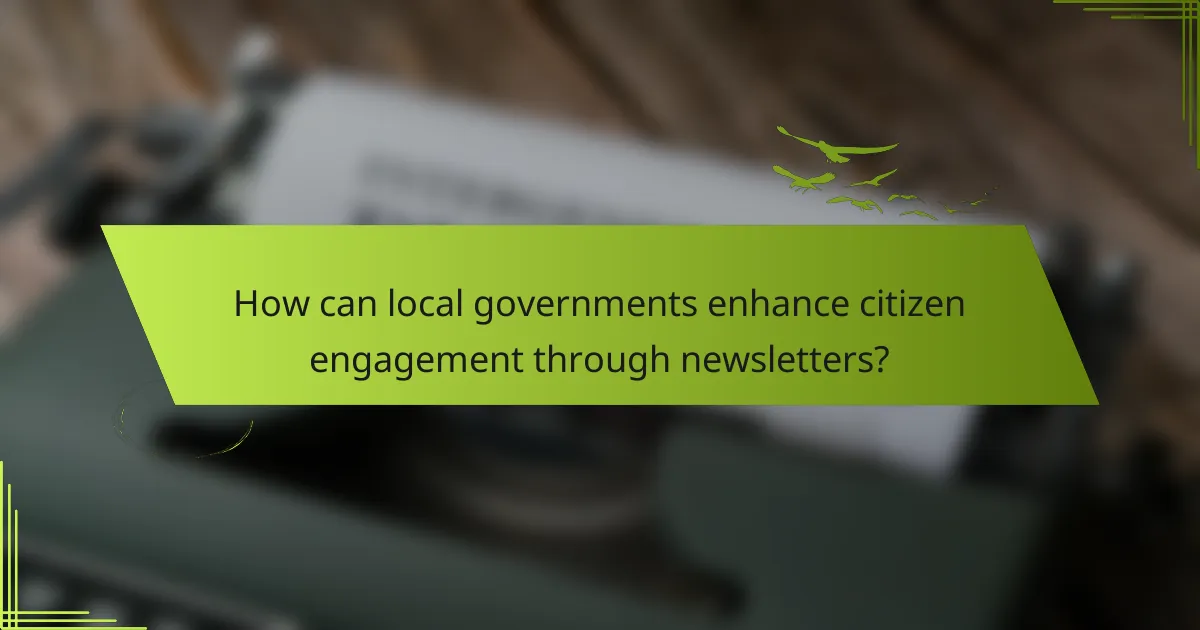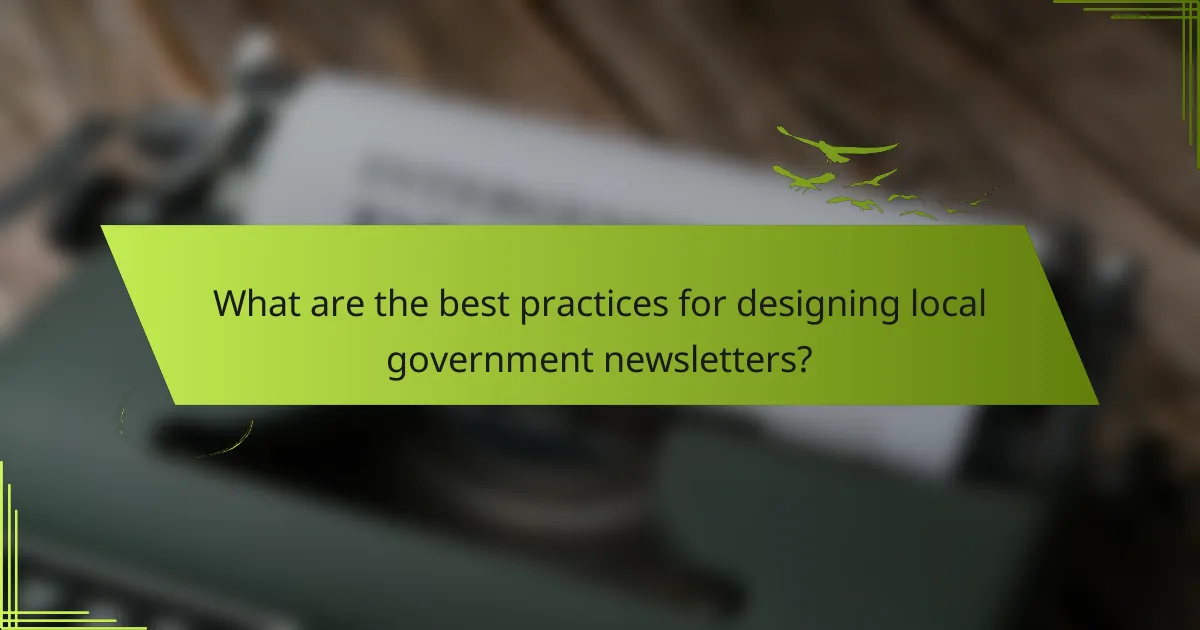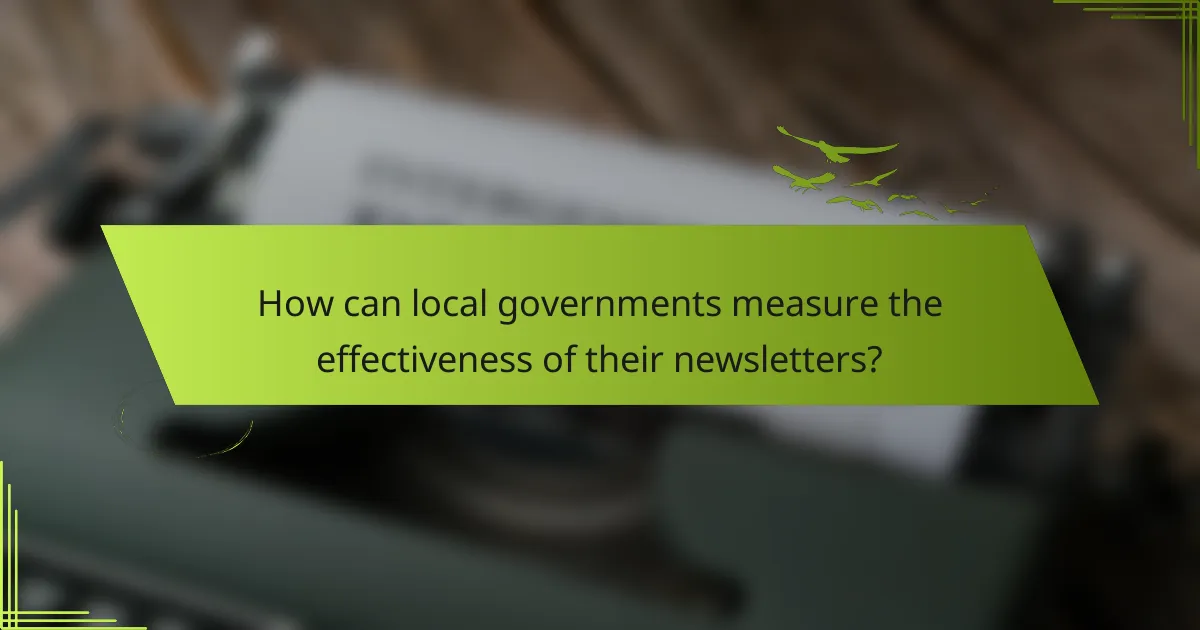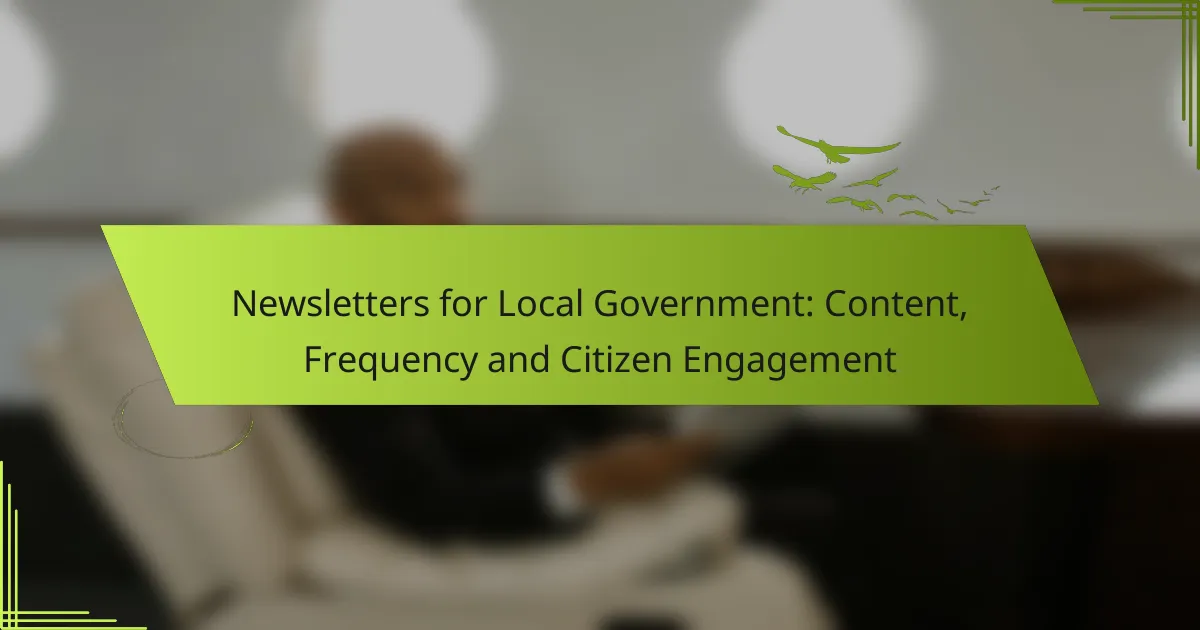Local government newsletters serve as a vital tool for enhancing citizen engagement by delivering relevant information and fostering community involvement. By focusing on key topics such as community events and public service updates, these newsletters create a two-way communication channel that keeps residents informed and encourages their participation. Ideally, newsletters should be distributed monthly to quarterly, ensuring that citizens receive timely updates on local initiatives and issues that matter to them.

How can local governments enhance citizen engagement through newsletters?
Local governments can enhance citizen engagement through newsletters by providing relevant information, fostering community involvement, and encouraging feedback. Effective newsletters create a two-way communication channel that keeps citizens informed and involved in local issues.
Interactive content features
Incorporating interactive content features in newsletters can significantly boost citizen engagement. Elements such as polls, quizzes, and clickable links to local events encourage readers to participate actively rather than passively consuming information. For example, a local government could include a poll about community priorities, allowing citizens to voice their opinions directly.
Additionally, embedding videos or infographics can make the content more appealing and easier to understand. These features not only enhance engagement but also help convey complex information in a digestible format.
Personalized communication strategies
Personalized communication strategies can greatly improve the effectiveness of newsletters. By segmenting the audience based on demographics or interests, local governments can tailor content to meet the specific needs of different groups. For instance, families might receive information on school events, while seniors could get updates on health services.
Using citizens’ names and addressing their specific concerns can create a sense of connection and relevance. This approach fosters a more engaged community, as residents feel their individual voices are being heard and valued.
Feedback mechanisms
Implementing feedback mechanisms is crucial for understanding citizen needs and improving newsletter content. Local governments should include clear options for readers to provide input, such as surveys or dedicated email addresses for suggestions. This not only shows that the government values citizen opinions but also helps refine future communications.
Regularly reviewing feedback and making adjustments based on citizen responses can lead to higher satisfaction and engagement levels. For example, if many residents express interest in local environmental initiatives, the newsletter can prioritize related content in future editions.

What content should be included in local government newsletters?
Local government newsletters should focus on relevant and engaging content that informs citizens about community happenings, services, and initiatives. Key topics include community events, public service updates, and local projects, all aimed at enhancing citizen engagement and participation.
Community events and announcements
Community events and announcements are essential for keeping residents informed about local happenings. These can include town hall meetings, festivals, and public forums, which encourage citizen participation and foster a sense of community.
When listing events, include essential details such as date, time, location, and any registration requirements. A calendar format can be effective for organizing multiple events, making it easy for residents to find what interests them.
Public service updates
Public service updates provide citizens with important information about local government services and changes. This can encompass updates on waste collection schedules, utility services, and public safety announcements.
Consider including tips for residents on how to access services or report issues, such as a dedicated phone line or online portal. Highlighting any changes in regulations or procedures can also help residents stay informed and compliant.
Local initiatives and projects
Local initiatives and projects showcase the government’s efforts to improve the community. This can include infrastructure developments, environmental programs, and community improvement projects that directly impact residents’ lives.
Provide updates on project timelines, funding sources, and expected outcomes. Engaging citizens in these initiatives through feedback opportunities or volunteer options can enhance community involvement and support for local government efforts.

What is the ideal frequency for local government newsletters?
The ideal frequency for local government newsletters typically ranges from monthly to quarterly, depending on the type of information being communicated and the needs of the community. Regular updates help maintain citizen engagement while ensuring that important news is timely and relevant.
Monthly newsletters
Monthly newsletters are effective for sharing routine updates, community events, and ongoing projects. They allow local governments to keep citizens informed about essential services, upcoming meetings, and initiatives that require public input.
When creating a monthly newsletter, consider including sections for announcements, highlights from recent council meetings, and a calendar of events. This structure helps residents stay connected and encourages participation in local governance.
Weekly updates for urgent news
Weekly updates are suitable for urgent news that requires immediate attention, such as emergency alerts or significant changes in local policies. These updates should be concise and focused, ensuring that citizens receive critical information without overwhelming them.
For effective weekly updates, utilize email or social media platforms to reach a broader audience quickly. Highlight key points and provide links to more detailed information for those who wish to learn more.
Quarterly reports for in-depth insights
Quarterly reports offer a comprehensive overview of local government activities, financial performance, and strategic goals. These reports are ideal for sharing in-depth analyses and progress on long-term projects, helping to foster transparency and trust within the community.
In a quarterly report, consider including metrics on service delivery, budget allocations, and community feedback. This detailed approach not only informs citizens but also invites them to engage in discussions about future priorities and initiatives.

What are the best practices for designing local government newsletters?
Effective local government newsletters should prioritize clarity, engagement, and accessibility. By following best practices, such as mobile-friendly layouts, clear calls-to-action, and consistent branding, local governments can enhance citizen engagement and ensure important information reaches their audience.
Mobile-friendly layouts
Designing newsletters with mobile-friendly layouts is essential, as many citizens access information via smartphones. A responsive design ensures that content adjusts seamlessly to different screen sizes, improving readability and user experience.
Consider using single-column formats and larger fonts to enhance legibility on smaller devices. Test your newsletter on various devices to ensure it looks good and functions well across platforms.
Clear call-to-action buttons
Incorporating clear call-to-action buttons is vital for encouraging citizen engagement. These buttons should stand out visually and use concise language that directs readers to take specific actions, such as signing up for events or providing feedback.
Position these buttons prominently within the newsletter, ideally at the beginning and end of the content. Use contrasting colors to make them easily identifiable and ensure they are clickable on both desktop and mobile devices.
Consistent branding elements
Consistent branding elements help establish trust and recognition among citizens. Use the same color schemes, logos, and fonts across all newsletters to create a cohesive identity that reflects the local government’s image.
Incorporate branding elements in headers, footers, and throughout the content. This consistency reinforces the government’s presence and makes it easier for citizens to identify official communications.

How can local governments measure the effectiveness of their newsletters?
Local governments can measure the effectiveness of their newsletters through various metrics that reflect engagement and reach. Key indicators include open rates, click-through rates, citizen feedback, and overall engagement metrics.
Open and click-through rates
Open rates indicate the percentage of recipients who opened the newsletter, while click-through rates show how many clicked on links within the content. A good open rate typically ranges from 20% to 30%, whereas click-through rates around 2% to 5% are considered effective. Tracking these rates helps identify what content resonates with citizens.
To improve these rates, local governments should craft compelling subject lines and ensure the newsletter is mobile-friendly. Regularly analyzing these metrics can guide content adjustments to better meet community interests.
Citizen feedback surveys
Citizen feedback surveys are essential for gathering direct input on newsletter content and format. Governments can distribute surveys via email or through community events, asking specific questions about what readers find valuable or what they would like to see more of. Aim for a response rate of at least 10% to ensure meaningful insights.
Incorporating open-ended questions allows citizens to express their thoughts freely, providing qualitative data that can enhance future newsletters. Offering small incentives for survey completion can also increase participation rates.
Engagement metrics analysis
Engagement metrics analysis involves examining how citizens interact with the newsletter beyond just opens and clicks. This includes tracking social media shares, comments, and overall website traffic generated from the newsletter. These metrics help gauge the broader impact of the newsletter on community engagement.
Local governments should consider setting benchmarks based on previous newsletters to assess improvements or declines in engagement. Regularly reviewing these metrics can help refine strategies and ensure the newsletter remains a valuable communication tool for the community.
